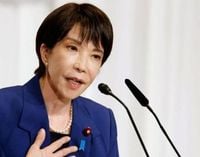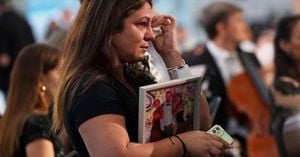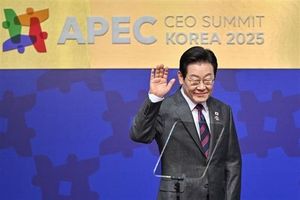Japan finds itself at a historic crossroads this October, as Sanae Takaichi, sworn in on October 21, 2025, becomes the nation’s first female prime minister. The ceremony, held at the Imperial Palace alongside Emperor Naruhito, marked not just a personal milestone for Takaichi but also a transformative moment for Japanese politics. Yet, there’s little time for celebration—the days that followed have thrust her directly into a diplomatic spotlight, with the world watching closely as she navigates her first major international test.
According to CNN, Takaichi’s early agenda is packed: she’s set to attend the ASEAN Summit in Malaysia and the APEC meeting in South Korea, but the most anticipated event is her upcoming summit with U.S. President Donald Trump. This meeting, scheduled for October 28 in Tokyo, has already been preceded by a “very good” phone call on October 25, as described by Trump himself. The stakes couldn’t be higher. With Takaichi’s limited diplomatic experience and Trump’s famously unpredictable approach to foreign affairs, their face-to-face encounter is shaping up as a defining moment for both leaders.
Trump, currently on an Asian tour, has not been shy about sharing his opinions. On board Air Force One, he praised Takaichi as “wonderful, beautiful, and very friendly.” He also lauded her choice of the American-made Ford F-150 pickup truck as a diplomatic gesture, telling reporters, “She has good taste. It’s a great truck.” This purchase is more than a symbolic nod to American manufacturing; it’s part of a broader strategy by Takaichi’s government to ease trade tensions and solidify ties with Washington. The Japanese government, as reported by The Asia Business Daily, is even considering displaying the Ford trucks where Trump can see them and exploring their use for road and infrastructure inspections—a move that’s drawn some skepticism at home, given the trucks’ size on Japan’s famously narrow roads.
But the Ford F-150 is just the beginning. Takaichi is also reviewing ways to increase imports of American soybeans, liquefied natural gas (LNG), and automobiles. These gestures are seen as efforts to align with the Trump administration’s “Buy American” slogan and to demonstrate Japan’s commitment to deepening economic cooperation. The Associated Press noted that Takaichi is putting “everything on the line” to build a strong rapport with Trump, including emphasizing her status as the “direct disciple” of the late former Prime Minister Shinzo Abe—a figure revered for his leadership and close ties with the U.S.
At the heart of the upcoming summit are weighty issues: tariffs, regional security, defense spending, and the ongoing challenge of China’s expanding influence in technology and manufacturing. According to Reuters, Japan is preparing to present candidate projects for investment or equity participation in nine sectors, including semiconductors, pharmaceuticals, critical minerals, shipbuilding, and energy. There’s even talk of signing a memorandum of understanding to expand investment in shipbuilding—a sector both nations see as strategically vital.
The defense discussion is especially urgent. Japan’s government, according to multiple sources, plans to inform the U.S. that it will achieve its defense spending target of 2% of GDP within 2025—two years ahead of the previously stated 2027 goal. This commitment is seen as a response to shifting regional dynamics and rising security threats. Takaichi herself has stressed the need to “actively strengthen the foundations of defense,” although exactly how this will be funded remains a question, given Japan’s economic headwinds and ongoing tax policy debates.
Energy security is another pressing concern. Japan currently imports about 10% of its LNG from Russia—a dependence that Washington is urging Tokyo to reduce, especially as the yen’s depreciation threatens the country’s energy stability. Takaichi has promised to cut this reliance, but she’s also warned that moving too quickly could jeopardize Japan’s energy security, particularly at a time when global markets remain volatile.
On the domestic front, Takaichi faces no shortage of challenges. The Liberal Democratic Party (LDP), long Japan’s dominant political force, is still reeling from corruption scandals and internal divisions. Despite this, public support for Takaichi remains robust, hovering around 71%, according to CNN. Her government is backed by an unstable coalition, raising the stakes for her ability to deliver results both at home and abroad. She’s expected to focus on restoring trust within the party, refreshing its ranks, and presenting a steady hand to the international community.
Diplomatically, Takaichi is walking a tightrope. While she’s determined to maintain strong ties with the U.S., she’s also signaling a softer tone in relations with Israel and South Korea, hoping to foster multilateral cooperation amid growing regional instability. Her approach to China and the Koreas is described as moderate but firm—she’s made clear her commitment to regional stability, even as she seeks to reduce the burden on U.S. forces stationed in Japan by encouraging greater cooperation with neighboring countries. “There is growing understanding that cooperation between Japan and South Korea is a necessity in this unstable world,” she has emphasized, according to Kyodo News.
In a nod to her political roots, Takaichi is expected to highlight her status as Abe’s protégé throughout her meetings, aiming to reassure both domestic and international audiences that she will continue his legacy of cautious but decisive leadership. “This is a clear message to both domestic and international audiences: she is trying to continue Abe’s line of thinking, not Kishida’s or Ishiba’s,” noted a senior official, as reported by CNN.
Trump’s visit to Japan is also strategically timed, coming just before his scheduled meeting with Chinese President Xi Jinping. Christopher Johnstone, Japan Chair at the Center for Strategic and International Studies, told Reuters, “On the eve of the Trump-Xi summit, President Trump may be seeking to demonstrate the strength of U.S.-Japan relations to bolster his negotiating position.” The symbolism of Trump’s courtesy call on Emperor Naruhito, his summit with Takaichi, and his dinner with Japanese business leaders before departing for South Korea—all packed into a whirlwind three-day visit—has not been lost on observers.
As Takaichi herself has said, “There is no time to stand still.” The outcome of these meetings will not only shape her own political future but also set the tone for the U.S.-Japan alliance in the years ahead. With the world’s eyes fixed on Tokyo, the coming days may well define a new era in Japan’s domestic politics and foreign policy alike.




